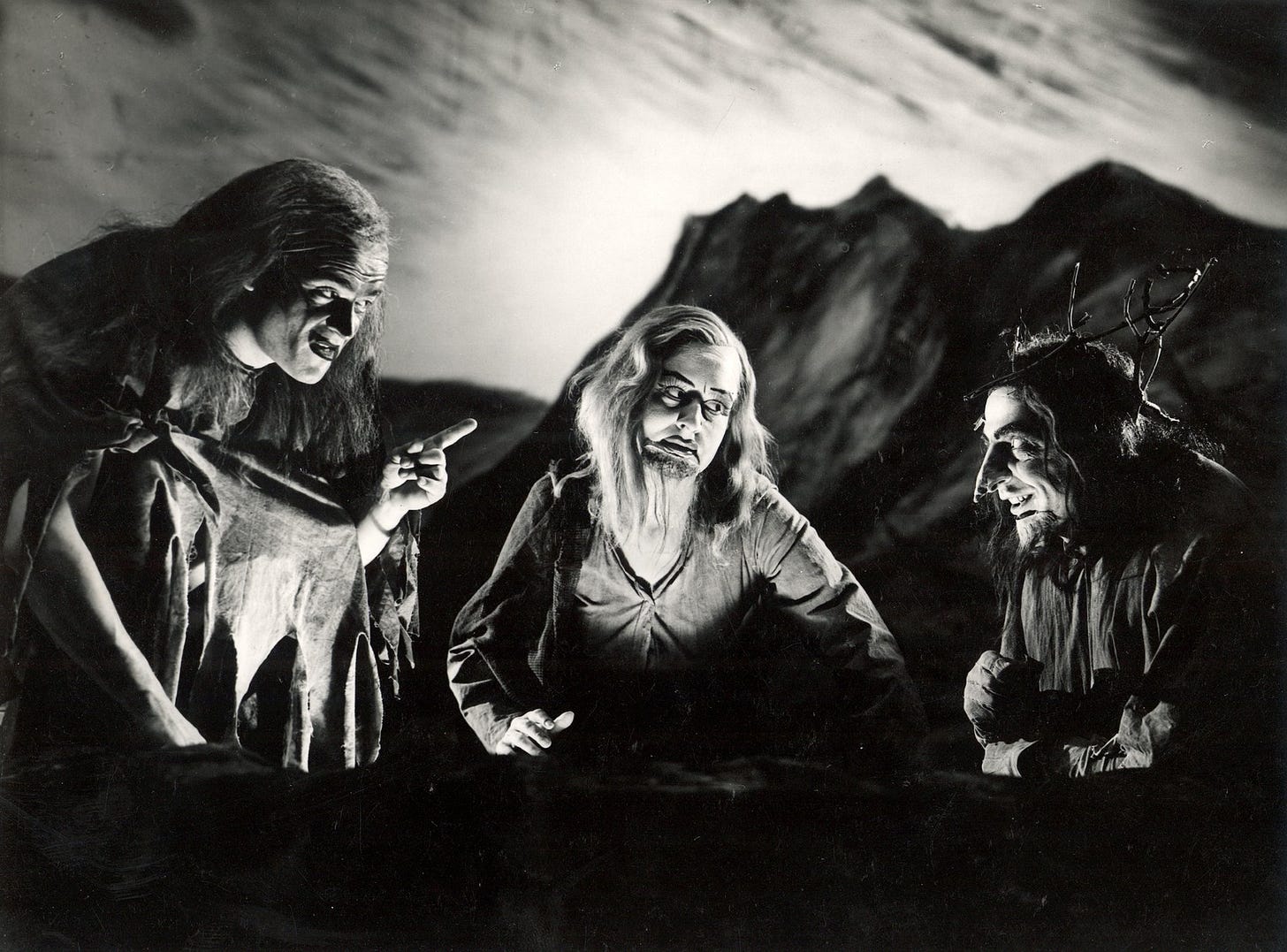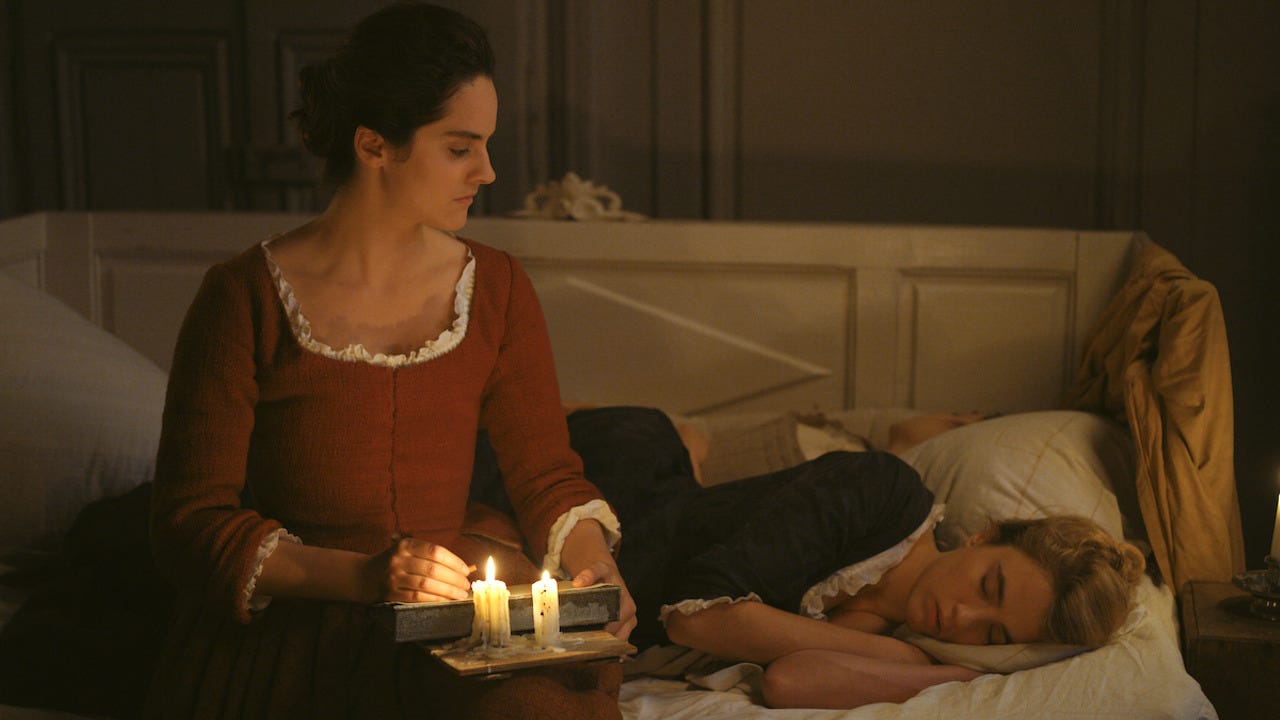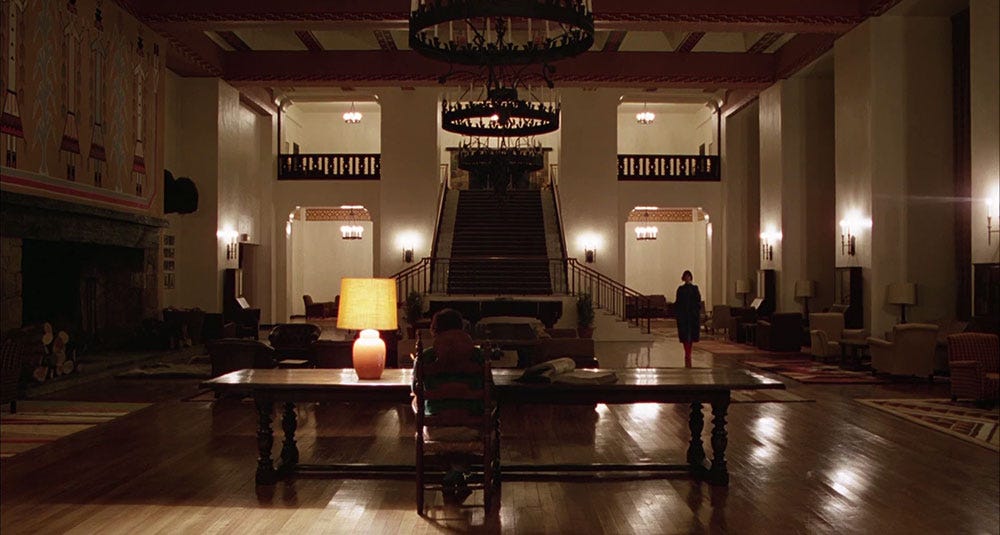Greetings!

This is a photo of the (in)famous witches’ prophecy scene from a 1946 production of Macbeth at the Royal Shakespeare Company, and it delights me to no end. It also has me thinking about women, and witches, and how spaces that cannot be understood by men where women freely associate without the male gaze are dubbed dangerous and the activities within sinister. Let’s dive in, shall we!
These weeks! They just start coming and they don’t stop coming, as our wise sage friends Smashmouth said, except they observed such about years and not weeks, though I suspect they would extend the philosophy to the latter, as well. I was feeling desperately uninspired this week, fully prepared to throw in the towel on this whole newsletter business (or, fuller disclosure, do some sort of copy and paste situation on an idea I wrote about in grad school—I still have that in my back pocket if this really goes to shit), but with just an overactive mind and anxiety, fear not! Inspiration will find you in the form of something you’ve overanalyzed and overthought when everyone else in your life seems to be able to live life like a normal person without constantly having to find patterns and make a theme of the whole damn thing. Perhaps I have just described, in essence, what it is to have an annoying urge and need to write your whole life.
If you’ve been so kind to read these newsletter, you’ll know that I have become obsessed with coziness in recent weeks. This happens every year, and yet the intensity of it this time is unusual; I am very much an outside person and am most myself when I am outside, but of course coziness in the cooler seasons is what happens when you come in from the outside; coziness cannot exist without a chilly and un-cozy outside, I think. So what is it, then? Why do I so long not only to cultivate this space for myself, but dream of cottages and homes and libraries filled will candles through film and books, too? Why am I so desperate to sink into these interiors with fire in the hearth and something bubbling on the range, with soft armchairs and herbs drying from the ceiling? (No I am not going to call it cottagecore because *some* of us have been cultivating these aesthetics since we were 8 and wanted to live at the local 19th century living history museum and churn butter all summer)

This desperation for coziness, I’ve noticed, has extended (or is perhaps exacerbated by) my movie selections. After watching Practical Magic last weekend, I was unable to shake the aesthetics of it: its warm tones, its world of women, its matriarchal witches, its iconic house with its soft and lush interiors. I was desperate for movies with similar energy: women-centered, aesthetically pleasing, a focus on community, with either the sparkle of magic or the enchantment of a period piece. I watched Enola Holmes and Portrait of a Lady on Fire over the course of the next few nights (mid-week movies! What a luxury), and I sought out each of these movies precisely because I wanted something homey, cozy, textured, warm. Throughout the week, I realized that there was something stronger connecting all these movies, and indeed the connection between them revealed what I was really craving when I sought out something warm-toned, with a fireplace, about women: the coziness in this movies is because they center the home (or in Enola Holmes’ case, part of the movie does), and each of them in their own way creates this sort of utopic domestic space free of the influence of men. Coziness, I have decided, is a specifically matriarchal endeavor.
Enola Holmes was precisely what I hoped it would be: spunky heroine, Victorian vibes, anachronistically feminist, lush English houses, dark libraries, martial arts-practicing suffragists. In the movie, Enola (sister of Sherlock, played by a Henry Cavill who, it must be said, perhaps has never looked better) describes what life was like growing up, being raised by her eccentric mother (Helena Bonham Carter!) in this little bubble of Ferndell Hall, where she received an exceptional education, full of science and reading and rigor and puzzles. Full of fresh air, exercise, marital arts, archery, lessons in decoding and ciphers. It’s the sort of life and education that simply could not have existed without men around; indeed, when Enola’s older brother Mycroft comes home, he shatters the cozy domestic bubble Enola and her mother had cultivated, sending Enola to a boarding school that is cold and hard where Ferndell is cozy and velvet-stuffed. Growing up at Ferndell was this sort of feminist (and feminine) utopia, and the fact that Enola notably has little-to-no experience in the outside world does nothing to undermine that utopia, nor that feminism.


Portrait of a Lady on Fire is about two women falling in love on a remote Briton coast in the late 18th century, but even more, I think, it’s about community, women’s space, and the haven that the drafty manor becomes for these women to enact and live out the freedom that they could not in society-at-large. The home in Portrait is completely free of the male gaze, and the camera brings us deep into this inner world, this inner sanctum of what women are like and, indeed, can be like when there are no men around. Conversations happen over domestic tasks like preparing dinner, mending, eating some bread and cheese. When a man shows up in the kitchen towards the end of the movie, it is purposefully jarring; it feels like he shouldn’t be there, like he is out of place.


So I was thinking about all this: the witches of Practical Magic, the feminist outpost of Ferndell Hall in Enola Holmes, the women-only haven of those few days in that manor in 18th century Brittany in Portrait of a Lady on Fire , and I sort of realized that in being drawn to vague “coziness,” I am being drawn to images, stories, and settings that center women’s space and portray what happens there when men are of no concern. And these places can be revolutionary, can be liberative, even. Many scholars have written about the separation of the spheres (public/private; male/female) that were codified through capitalism, though women have long carved out domestic space and tended to it, of course, before capitalism made it an imperative. So much of the white feminism I spouted as a teen and throughout college (before learning better!) was about removing women from that domestic sphere that we are taught is inherently oppressive. Working is the goal, getting women out of the house is the goal. Girlboss, climb the ladder, etc., etc. But this is Lean In feminism; it is deeply capitalist. To be home and cultivate a life at home is not inherently bad, and there are ways to do this that resist oppression, or at least find freedom within its structures. The home can be a place of safety, of community, of coziness, of leisure, free from the male gaze if set up like the homes in these films. It can be a rich, self-sustaining universe.
In these films, these homes are places where women establish mini matriarchies, where they live and exist in familial structures that do not align with the typical nuclear family. They do internal reproductive (as in sustaining life, not recreating it) work, they care for themselves both tangibly and emotionally. It is not a coincidence, in this month of spookiness and witches, that I am drawn to these sorts of films; indeed, it is women and communities of women whose households operate independently (or at least outside of the typical, patriarchal societal structure) who have often been dubbed “witches” throughout human history. Think of the healer in the cabin in the woods; think of the midwives living on the edge of town.
All this matriarchal coziness was brought even more into relief by a film that showed the horror and violence inherent in its total absence. Until last Wednesday night, I had never seen The Shining, and—hot take! Forty years late to the party!—it was incredible and I can’t stop thinking about it. The movie’s “point” or “theme”—“what it’s about,” shall we say—is notoriously opaque, with lots of film-type men theorizing that it’s about the Holocaust, of the genocide of Native Americans, or even the moon landing (??). Watching it for the first time though, its point seemed so obvious to me: it’s about toxic masculinity and the pressures of being a man in America in the late and turbulent 1970s, sure, but even more, I think it’s about the violence—verbal, physical, emotional—that men enact on women and children, and how that is a daily, lived horror. Watching it, I thought that Wendy is so obviously the protagonist. Not Jack, her husband who goes slowly mad, and who—it’s important to note—is dismissive and violent even before the hotel gets its claws in him. To me, on just one watch, The Shining is about the ways men get to swirl around in a tumult of anger and violence and selfishness while women—both for sanity and safety, and because it’s what women have always done, I think—must tend to those men’s needs and whims and emotions, all the while continuing the domestic tasks that sustain and support the life around them, even of the people who hurt them. While Jack spends hours at his typewriter, it is Wendy who maintains the hotel, who flips the breakers and cooks for everyone and tends to her son. Under the threat of constant violence, she adapts. And that is a special type of horror.
This, of course, stands in direct contrast to the movies I watched earlier in the week, all cozy and matriarchal. Wendy has no other women with her at the hotel. She is alone with her husband and her son. Unlike the ladies of Practical Magic or Enola Holmes or Portrait, Wendy lives under the constant threat and surveillance of the male gaze. The Shining is what these spaces can feel like when they are defined and controlled by the male gaze. And the feeling of the interiors reflects this: they are cavernous, empty. There is so much empty space in this hotel. It looks cold. It feels cold. It feels threatening. It is not warm, emotionally or literally. Here is Wendy, walking toward Jack in a scene in the Colorado Lounge. She is dwarfed by the space and she walks toward the danger that she cannot avoid, because she must tend to it.

I’ve decided that coziness is matriarchal, and it can even be safe and protective and mystical to those looking in from the outside. Perhaps this is why we’re so drawn to the aesthetics of witches, the idea of cottagecore (blech) and herbs hanging on the walls and fires in the hearth and bubbling cauldrons on the stove: these are people and spaces that have traditionally been marked by society as “different,” and they can be places where men do not desire to go, where women—like the witches in Practical Magic, like Enola and her mother, like 18th century French lesbians—can cultivate their own sort of matriarchy, with beds unmade, with martial arts lessons and dinner at whatever hour you feel like it, with margaritas and a joyous, exuberant dance at midnight.
Left in Cart:
I’m going to be honest, not much was left in cart this week. I signed a contract for a new part time job, and with the joyful burst of confirmed employment comes (in my experience) a temporary, buoyant comfort with purchasing. I bought two candles that I didn’t buy for a few weeks (growth!), and lots of little annoying needs are coming up (also, I am going camping this weekend and so had to do some outfitting for that), so this has been a bad week for prudently leaving in cart.
However, I am eyeing (and have not bought! And likely will not buy!) spices from the Spice House, which I’ve heard wonderful things about and seems to just have the dreamiest blends that make me want to cook things worthy of them. The Ras El Hanout and the Berbere have, in particular, been haunting me as I think about big batches of stews and daals and perfect-leftover sorts of things for the season.
All that tea from Mountain Rose Herbs last week? Still in cart! Proud of self!
Listening:
Spotify playlists continue to look out for me when I want a mood rather than a specific album or artist, etc., etc. Five years ago, I was alone in Louisville for Halloween. It was a cool, crisp, overcast, blustery fall day—just the perfect Halloween, my fellow Halloweenheads know what I mean—and I drove around all day, stopping at a farmer’s market all set up under a massive old tree shedding its yellow leaves, holing up in a bookstore, wandering the old cemetery in town, all while listening to this Southern Gothic playlist. I rediscovered it this week while needing something to match my moody, foggy morning drive on Sunday morning, and there’s nothing better: haunting folk songs, murder ballads, the ache and echo of ghosts in mountain hollows.
Watching:
This whole post sort of became a bloated Watching section, but in addition, we also watched Hereditary. Ari Aster, you infuriate me! Both here and in Midsommar: 1.75 hours of pitch-perfect mood building and suspense and aesthetic perfection, all to devolve into senseless pagan bacchanal at the end in a way that I find deeply unsatisfying but very few people seem to agree with me. I wonder if we all love the aesthetics of cults and paganism and such so much that we don’t realize that the script kind of falls apart. Idk! Film criticism!
Reading:
After falling under the spell of Circle of Friends, I am now about 50 pages away from finishing another Maeve Binchy book, The Glass Lake. These books are just so compulsively readable—the pages fly by and you just keep flipping and flipping and suddenly you’re not far from the end of a 700+ page book. I have a used copy of Daphne du Maurier’s Jamaica Inn arriving today, which is a period piece about a mystery at a spooky inn amidst the moors of 1820 Cornwall, and I cannot wait. I (like many, it seems) have Rebecca on hold at the library, but it won’t arrive in time for Halloween, so I’m giving another of hers a go next.
Oh, and I was right about Jonathan Strange & Mr. Norell—I read about three pages and put it away. I just don’t have the time, patience, or energy for books that are Projects, you know?
Eating:
Folks, it’s Concord grape season. As they say, if you know, you know. But if you don’t! Let me bring you on this journey. If, like me, you’re neutral-to-negative on grocery store red or green grapes (they’re boring, they’re too sweet, yes they’re fun to pretend are eyeballs when you are a kid, let’s move on), let me sell you on the Concord grape.
As a lover of all things foods and agriculture, I try to eat seasonally as much as is viable (living in New England and the mid-Atlantic for most of my life, not much grows in winter, and my ancestors did not survive the potato famine just for me to eat only potatoes and other storage vegetables for a whole winter) and affordable (let’s be honest!), not only because it’s important to me, but because my body craves the new textures and colors as the seasons shift. Right now, that means rich purples of these grapes, deep oranges of squashes, dark greens of collards and kale. These grapes have seeds, which I understand means that there is a learning curve, but you get used to kind of uh, spitting the seeds out, and it’s all worth it for the supremely grape-y flavor. If you’re like “eh? Seeds? Idk!”
Another hot take (that I hate even saying is a hot take because I feel like there was, for awhile, this white mean-girl culture where hating things people like was treated as its own personality [cough Alison Roman cough]) is that apples are also mostly not that good! Or, to be more precise, the vast majority of grocery store apples (yes, I recognize my snobbery here) are not that good! I’ve made my hatred of the vile red delicious known publicly before, in the form of these notes that were presented as sort of a public testimony for one of my classes in grad school (oh, div school) but I’m ready to extend that distaste to even the crispest, sweetest grocery store apple, mostly because, like red grapes, they’re just sweet without much flavor. ANYWAY I’M HERE, ONCE AGAIN, TO SHARE MY PASSION FOR HEIRLOOM VARIETIES. I’ve made a habit of going to the big market here in Raleigh every weekend and there’s a stand from an heirloom apple orchard, and we are eating our way through the varieties, and I am here to report that thus far, the Arkansas Black stands out. It’s also the most gorgeous purply-black-red color and having a bowl of them out makes me feel like I’m in all these still lifes that I’m so drawn to lately.
Other than that, it’s been a lot of soup this week. Also, I got a bunch of eggplant and okra at the market, so I might give this Indian eggplant and okra recipe a try, OR this Bhindi Masala. Will. Report. BACK.
Until #5,
Anna


